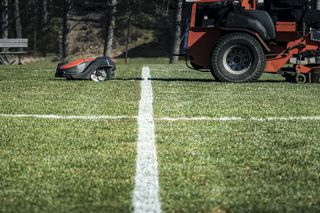
The perfect pitch
Creating the perfectly awesome lawn is one thing. But how do you make your grass survive a lifetime of games, sports and gardening activities without it getting worn thin? Is it even possible? We turned to one of the best in the business for some answers.
Jonathan Calderwood is the Head Grounds Manager at Parc de Princes, home arena to football club Paris Saint Germain (PSG). Jonathan knows all about creating and maintaining the perfect lawn – and the importance of doing so.
“The pitch is the first thing that the fans see when they enter the stadium and it’s the first thing the players complain about if they lose a match. And since non-football events are important for the return of investment of a stadium, the quality of the pitch is important in that perspective as well. In other words: the pitch is a vital business asset,” says Jonathan.
The boss of the stars
Jonathan’s position means that he decides how the pitch is to be cared for and maintained, when it may be used and by whom. In other words, it isn’t the trainer or the manager who decides whether Ibrahimovic, Cavani and Thiago are allowed out on the field – it’s the Head Grounds Manager who’s in charge.
Prior to being headhunted for PSG, Jonathan worked for many years as Grounds Manager for Aston Villa in the English Premier League. While there, he was crowned English Premier League Groundsman of the year in both 2009 and 2012. Jonathan is also chairman of the ESSMA(European Stadium & Safety Management Association) expert group on pitch management, whose mission is to support stadiums and their groundsmen with experience and knowhow.
Jonathan Calderwood's tips on getting the perfect lawn
- The right soil. Grass roots need air and space to thrive. Use well-drained, nutritious, light and sandy soil that is loose enough for the grass roots to spread easily and absorbent enough to collect water. Also, make sure it’s rich enough to provide the plant with nutrients.
- The right amount of water at the right time. Like most other plants – grass requires sunshine, air, water and nutrition to thrive. One fundamental rule regarding watering your lawn is that it’s better to give your lawn a generous through-the-roots dose of water every now and again, rather than to water sparsely but frequently. This latter method is more suitable if you have recently planted a fresh new lawn.
- Continuous fertilisation. A lawn is always hungry and needs a continuous supply of fertiliser. It’s important to start with a soil rich in nutrients and to keep adding fertiliser so that the lawn receives assistance in growing strong and healthily green.
- Mow sensibly. Avoid cutting the grass too short – no more than a third of its shoot length – and mow frequently. A length of three to four centimetres is ideal for the average lawn. Do not mow under dry periods when the grass is under severe stress, as that would inhibit growth and make it hard for the grass to recover. Also, keep the mower blades sharp.
- Aerating. Aerating alleviates compacted soil and allows water to penetrate deeper, producing deeper roots. It also creates space in the soil for penetration of air, water and nutrients. You can rent an aerator or get the service provided for you by lawn care companies.
- Thatch control. Thatch can harbour insects and diseases and unhealthy amounts of hatch prevent water and nutrients from reaching the roots. Use a dethatching machine or contact a lawn care company to control the thatch.









